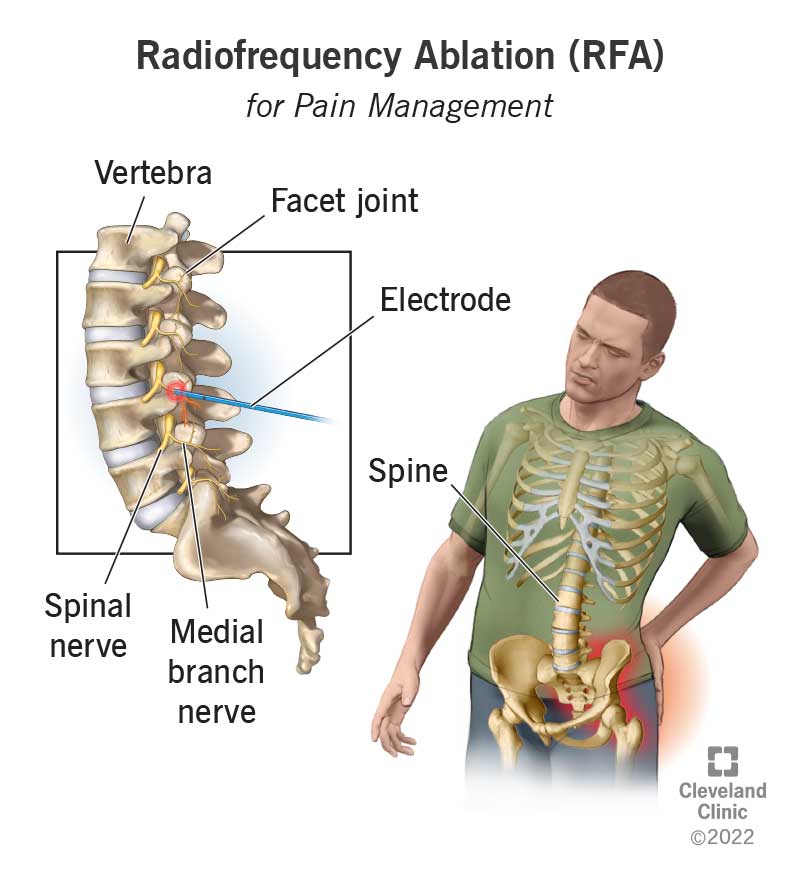Last Updated on 1 year by Francis
Radiofrequency ablation is a safe and effective treatment option used to decrease pain. It works by using targeted energy to reduce nerve sensations to the affected area. But how long does radiofrequency ablation last? In this article, we will discuss the various factors that influence the duration of radiofrequency ablation and how long you can expect the effects to last. We will also cover the potential side effects and risks of the procedure so that you can make an informed decision. So, if you’re considering radiofrequency ablation as a treatment option for your pain, read on to find out how long it will last.
Contents
What is Radiofrequency Ablation?
Radiofrequency ablation is a medical procedure used to treat chronic pain and other conditions. The procedure involves applying an electrical current to a specific area of the body to reduce nerve activity and reduce pain. During the procedure, a thin needle is inserted into the affected area, and the current is applied to the tissue. The electrical current essentially numbs the area, reducing pain and other symptoms.
Radiofrequency ablation is a minimally invasive procedure that can be done in an outpatient setting. It is often used to treat conditions like arthritis, fibromyalgia, and chronic back pain. Radiofrequency ablation has been found to be an effective treatment for chronic pain, and it can provide relief for up to a year or more.
How Long Does Radiofrequency Ablation Last?
The duration of pain relief from radiofrequency ablation can vary from person to person, but it is typically effective for up to a year or more. Some patients may experience pain relief for up to two years, depending on the severity of the condition. The length of time that pain relief will last depends on the individual and their condition.
Radiofrequency ablation is generally considered a safe and effective treatment for chronic pain. It is a minimally invasive procedure with a relatively low risk of complications. The most common side effects include soreness, swelling, or bruising at the site of the procedure.
Risks of Radiofrequency Ablation
Although radiofrequency ablation is a safe and effective treatment for chronic pain, there are some risks associated with the procedure. The most common risks include infection, nerve damage, or tissue damage. There is also a risk of bleeding or bruising at the site of the procedure.
In addition, radiofrequency ablation may not be effective for all types of pain. It is important to discuss any potential risks and benefits of the procedure with your doctor before having the procedure.
Recovery After Radiofrequency Ablation
Recovery after radiofrequency ablation is usually relatively quick and easy. Patients may experience some soreness or swelling at the site of the procedure, but this should resolve within a few days. It is important to follow any instructions provided by your doctor for the best results.
Long-Term Benefits of Radiofrequency Ablation
Radiofrequency ablation can provide long-term pain relief for up to a year or more. The procedure can reduce pain and improve quality of life for many patients. It is important to discuss any potential risks and benefits of the procedure with your doctor before having the procedure.
Top 6 Frequently Asked Questions
What is Radiofrequency Ablation?
Radiofrequency ablation (RFA) is a minimally invasive procedure used to treat chronic pain. During the procedure, a thin, needle-like electrode is inserted into the area of the body where the pain originates. The electrode emits radiofrequency energy, which is then used to heat up the affected area and destroy the nerve tissue responsible for transmitting pain signals to the brain. RFA is usually done as an outpatient procedure and is generally considered to be safe and effective for treating chronic pain.
How Long Does Radiofrequency Ablation Last?
Radiofrequency ablation is typically a long-lasting treatment for chronic pain. In most cases, the effects of RFA can last for up to a year or more, although the exact duration of relief varies from person to person. Many patients report that they experience significant pain relief after the first treatment, and that the effects can last for up to a year or more.
What Are the Benefits of Radiofrequency Ablation?
Radiofrequency ablation offers numerous benefits over other treatments for chronic pain. It is a minimally invasive procedure, with a short recovery time and minimal risks. Patients typically experience significant pain relief after the first treatment, and the effects can last for up to a year or more. Additionally, RFA can reduce the need for medication and has few side effects.
Who Is a Good Candidate for Radiofrequency Ablation?
Radiofrequency ablation is typically recommended for those suffering from chronic pain that is not responding to other treatments. Generally speaking, any adult who is in good health and has not had a previous reaction to anesthesia is a good candidate for RFA. It is important to discuss the procedure with your doctor to determine if it is the right treatment for you.
What Are the Risks of Radiofrequency Ablation?
Although radiofrequency ablation is considered to be a safe and effective treatment for chronic pain, there are some potential risks associated with the procedure. These include infection, bleeding, nerve damage, and tissue damage. Additionally, there is a small risk of burning or scarring in the area where the electrode was inserted.
How Is Radiofrequency Ablation Performed?
Radiofrequency ablation is usually performed as an outpatient procedure. The area of the body where the pain originates is numbed with a local anesthetic, and a thin, needle-like electrode is inserted into the area. The electrode then emits radiofrequency energy, which is used to heat up the area and destroy the nerve tissue responsible for transmitting pain signals to the brain. The entire procedure typically takes less than an hour to complete.
Pain management specialist Ann Cherie Foxx MD: How long does radiofrequency ablation back pain last?
Radiofrequency ablation is an effective, long-term solution for individuals suffering from chronic pain. The procedure is minimally-invasive, allowing patients to experience relief from their symptoms with minimal side effects and a short recovery period. It is important to note, however, that the length of time that radiofrequency ablation can provide relief from chronic pain can vary depending on the individual’s condition and the type of radiofrequency ablation used. On average, patients can expect to experience a significant reduction in pain for up to two years after the procedure, but it is possible to receive lasting relief for up to five years or more. Radiofrequency ablation can be a great option for those looking for a safe, effective, and long-term solution to their chronic pain.


.jpg)
.jpg)

.jpg)


